A. Introduction
Robotic vacuum cleaners (RVCs) are devices that autonomously navigate floor plans, utilizing onboard sensors and software to meticulously remove dirt, dust, and debris. The introduction of RVCs has demonstrably revolutionized the home cleaning industry by enhancing efficiency and liberating users from a traditionally time-consuming chore. This allows individuals to dedicate their time to more productive or leisure activities. They also provide consistent cleaning, maintaining a higher standard of cleanliness with regular use. Moreover, their compact design allows them to clean under furniture and in tight spaces that traditional vacuum cleaners might miss.
The technology used by the Robotic Vacuum Cleaner is different from that of the traditional vacuum cleaner. Some of these technological features are as follows:
The Sensor: This allows the device to navigate through the floor and avoid bumping into areas as well as falling from heights.
Short-Range Ultrasonic ToF: This is used to identify if the target surface is hard or soft, it is working on an average amplitude of a reflected ultrasonic signal. This technology senses the type of flooring (tile, carpet, or wood) and adjusts its cleaning effort accordingly.
VSLAM And LiDAR: This technology helps to build a virtual map of the room. Since they are viewing a virtual map of the room that they are going to clean they are capable of cleaning more efficiently covering the entire home.
Inertial Measurement Units (IMU): IMU sensors act like a compass and level for the robot sweeper. They track how it moves in all directions, including forward/backward, tilting, and turning. This allows the sweeper to “know” where it is and what it’s doing while cleaning.
B. Objective of this Patent Landscape
This Patent Landscape Report delves into the industry of robotic vacuum cleaners by analysing trends in patent filings. Our investigation focuses on three key areas: first, identifying emerging technologies and advancements that are shaping the future of robotic cleaning. Second, we examine filing patterns over the past decade (2014-2024) to understand how the industry has evolved and developed. Finally, the report sheds light on the key players who are driving innovation in this dynamic market.
To achieve these goals, we conducted an analysis of patents filed, published, and granted during the specified timeframe. Our search strategy employed a strategic combination of predetermined International Patent Classification (IPC) codes alongside targeted keywords. This approach ensured we captured the most relevant data to create a well-rounded picture of the robotic vacuum cleaner patent landscape.
C. Parameters used for patent landscape analysis
- Patenting trends for the years 2014 to 2024
- Distribution of patents based on assignees.
- Estimated top 10 publication countries
- Estimated top 10 assignee countries
- Estimated top 10 Priority countries
- Estimated top 10 industry areas
- Estimated top 10 owners between the years 2014 and 2024
- Technological classification based on IPC classification
- Activities of Competitors based on Area of Research (IPC)
1. Patenting trends for the years 2014 to 2024
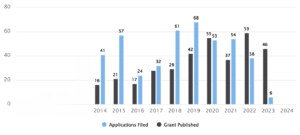
Figure 1: Patent filing trend between the years 2014 to 2024
Figure 1 depicts the distribution of patents for RVC between the years 2014 to 2024, including both applications filed and granted patents. The graph shows that highest number of applications were filed in 2019 with 68 patents followed by 2018 with 61 patents. However, the lowest number of patents were granted in the year 2014 with 16 patents compared to 2022 with 59 patents and 2020 with 55 patents. Overall, filings for RVC patent families saw a gradual increase but a sharp decline as depicted by the 2023 graph.
2. Distribution of patents based on assignees

Figure 2: Distribution of Patents based on the Assignees
As observed in Figure 2, Miele & CIE KG is the key player with 82 patents. The next key player is the Sharkninja Operating LLC with 52 patents. Electrolux AB has 46 patents while Dyson Technology LTD. has 39 patents. Next in line is LG Electronic Inc. with 31 patents, Irobot Corp. with 24 patents and Koninklijke Philips NV with 21 patents. The Seb Sa and Vorwerk & Co. Interholding Gmbh come next with 12 patents. Lastly, we have Omachron Intellectual Property with 11 patents.
3. Estimated top 10 publication countries between the years 2014 & 2024
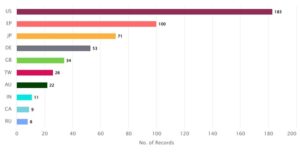
Figure 3: Distribution of Patents based on Publication Countries
Figure 3 indicates that the maximum patents belongs to the inventors of United States (US) with 183 patents and rest of the patents are issued to the inventors of other countries, ie European Patent Office (EP) with 100 patents, Japan (JP) with 71 patents, Germany (DE) with 53 patents, United Kingdom (GB) with 34 patents, Chinese Taipei (TW) with 26 patents being the prominent followed by Australia (AU) with 22 patents, India (IN) with 11 patents, Canada (CA) with 9 patents and the least Russian Federation (RU) with 8 patents.
4. Estimated top 10 assignee countries between the years 2014 to 2024
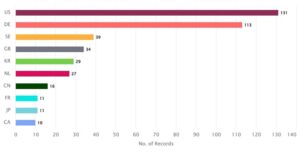
Figure 4: Distribution of Patent based on Assignee Countries
The Figure 4 indicates US (United States) is the key assignee country with 131 patents and rest assignee countries are Germany (DE) with 113 patents, Sweden (SE) with 39 patents being the prominent followed by Great Britain (GB) with 34 patents, Korea (KR) with 29 patents, Netherlands (NL) with 27 patents, China (CN) with 16 patents and France (FR) with 11 patents. The final three countries half include France (FR) with 11 patents, Japan (JP) with 11 patents and Canada (CA) with 10 patents.
5. Estimated top 10 priority countries between the years 2014 to 2024
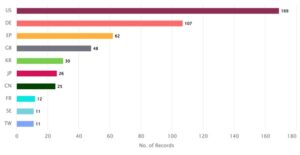
Figure 5: Distribution of Patents based on Priority Countries
Figure 5 indicates that United States (US) is the is the priority country for “RVC “with 169 patents and the rest of the priority countries are Germany (DE) with 107 patents, European Patent Office (EP) with 62 patents, United Kingdom (GB) with 48 patents, Korea (KR) with 30 patents, Japan (JP) with 26 patents, China (CN) with 25 patents, France (FR) with 12 patents, Sweden (SE) with 11 patents and Chinese Taipei (TW) with 11 patents.
6. Estimated top 10 industry areas between the years 2014 to 2024
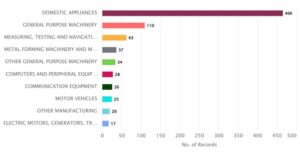
Figure 6: Top 10 industry areas between 2014-2024
The Figure 6 indicates major industries and technology areas between 2014 and 2024. Domestic Appliances is the major industry in the field with 446 patents. General Purpose Machinery follows next with 110 patents. The next in line is Measuring, Testing and Navigation industry with 63 patents. The Metal forming machinery industry holds 37 patents while the Other General-Purpose Machinery has 34 patents. The Computers and Peripheral Equipment has 28 patents followed by Communication Equipment with 26 patents. Motor Vehicles hold 25 patents while other manufacturing industries hold 20 patents. The least in number is the electric motors and generators industry with 17 patents.
7. Estimated top 10 owners between the years 2014 to 2024
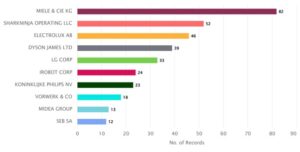
Figure 7: Top 10 industry owners between 2014-2024
As depicted in Figure 7, Miele & CIE KG is the major player with 82 patents. Miele & CIE KG manufacturer of high-end home appliances and commercial equipment, known for their quality and durability.The next key player is Sharkninja Operating LLC. with 52 patents, which is a producer focused on designing and developing innovative household appliances.. The next in line is Electrolux AB. with 46 patents. Dyson James Ltd. industry holds 39 patents while the LG Corp. has 33 patents. Irobot Corp. industry has 24 patents followed by Koninklike Philips Nv. with 23 patents. Vorwerk & Co and Midea Group both holds 18 and 13 patents each followed by Seb Sawith the least number of patents i.e. 12 patents.
8. Technology classifications based on IPC classification
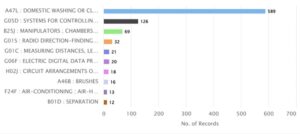
Figure 8: Technological Patent Distribution based on main IPC Code Classification
Figure 8 indicates the patent distribution based on main IPC code. The top spot is occupied by the domestic washing or cleaning with 589 patents families. Other major players include system for controlling or regulating non-electric variables with 126 patent families, manipulators with 69 patent families and radio direction with 32 patent families. Measuring distances, levels or bearings follows with 21 patents along with electric digital data processing with 20 patents . Circuit arrangements or systems for supplying or distributing electric power has 18 patents while the next in line ie. Brushes hold 16 patents. Air conditioning hold 13 patents each followed by Separation with the least number of patents i.e., 12 patents.
9. Activities of Competitors based on Area of Research (IPC)

Figure 9: Distribution of Patent based on Competitors and Area of Research (IPC)
Figure 9 depicts the distribution of patents based on competitors and area of research (IPC). The top spot occupied by IPC A47L9/28 ie installation of electric equipment hold 294 patents. Other major players include A47L9/04 ie driven brushes or agitators with 176 patent families and parts of machines not such as arrangment of switches, skirts, buffers, levers with 135 patent families. IPC A47L9/00 for details or accessories of suction cleaners with 129 patent families. Control of position or course in two dimensions with 121 patent families while next in line is floor sweeping machines and Nozzles with 38 patents. Lastly, we have A47L9/06 with fixed brushes and A47L9/14 with bags or the like at 35 and 34 patent families each.
D. Conclusion
Robotic Vacuum Cleaner (RVC), a newly introduced technology has slowly become one of the most popular pieces of technology and opened up new dimensions for the automated technological industry. The study indicates that the substantial number of patents is filed by inventors of the US (United States) and Miele & CIE KG (Germany) being the major players. The study also shows that there are very less patents filed when it comes to manufacturing industries when Domestic Appliances industry. Data shows that there are maximum published patent families related to the RVC worldwide, of which 131 are from US applicants. In terms of innovation, the RVC industry may be quite competitive despite the presence of a handful of very large companies. Based on the list of top applicants, it is clear the leading patent filers include the Miele & CIE KG, Sharkninja Operating LLC, Electrolux AB and Dyson Technology LTD.
Authors: Ambika Menon, O.P. Jindal Global University and Deeksha. S PES University
Please contact us at info@origiin.com to know more about our services (Patent, Trademark, Copyright, Contract, IP Licensing, M&A of companies)
Subscribe to YouTube Channel HERE
Join LinkedIn Group: Innovation & IPR
WhatsApp: +91 74838 06607




